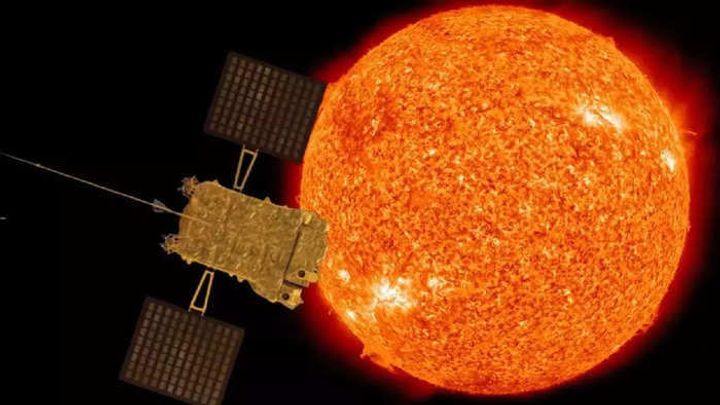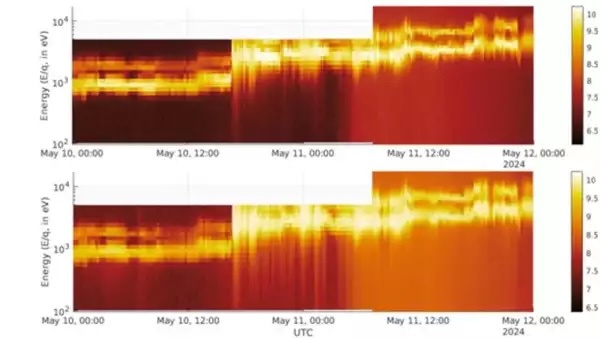16.05.2024

The Sun has been throwing some major temper tantrums lately, its active sunspot AR13664 directing multiple intense X-class flares and coronal mass ejections (CMEs) towards our planet since the beginning of May. A recent geomagnetic storm, deemed to be the strongest since 2003, struck Earth earlier this month, causing disruptions to communication and GPS systems.
The Indian space agency ISRO, which had front-row seats to the debacle, was able to remain on top of these events. On high alert during the entire solar drama, the space agency’s satellites were able to dodge the worst of the storm’s impacts while its spacecraft Aditya-L1 and Chandrayaan-2managed to collect quite a bit of data on the event.

A signature of the solar storm captured by an instrument onboard the Aditya-L1 spacecraft, released by ISRO on May 14, 2024. Aditya-L1 ISRO
Aditya-L1 is stationed at a special point between Earth and the Sun, constantly monitoring our fiery neighbour. It used its ASPEX instrument to measure the fast solar wind, hot plasma, and energetic particles released during the solar storm. It also used its X-ray sensors to directly see the powerful X-class flares, and its magnetometer picked up changes in the magnetic field between planets.
While Aditya-L1 kept a watchful eye on the Sun, Chandrayaan-2, orbiting the Moon, provided another vantage point. The spacecraft used its X-ray monitor (XSM) to observe various aspects of the storm. It tracked X-rays from the Sun, automatically identified strong flares, and monitored the local high-energy particle environment. The data from XSM showed an increase in nearby charged particles starting around May 9, with brief dips due to the spacecraft's movement around the Moon.
As for ISRO’s 30 other GEO spacecraft or Earth Observation Satellites, no major upsets or anomalies were reported. However, the solar storm did spark an increase in atmospheric density, which led to increased orbit decay — where the orbital radius decreases due to atmospheric drag. According to ISRO, some satellites experienced decay 5-6 times higher than usual on May 11.
The intense solar activity caused slight deviations in their momentum wheels, requiring adjustments. But these were just bumps on the road, and no major damage or loss of function was reported.
By capturing the details of this solar storm, ISRO has gained valuable insights into the Sun's behaviour. This data will be crucial for developing better prediction models and safeguarding our infrastructure from future solar events. So, the next time the Sun throws a tantrum, we'll be even more prepared, thanks to ISRO's watchful eyes in space.
Quelle: Business Insider India
+++
Indian satellites suffered no outages during recent high-intensity solar storms, says ISRO
Aditya L1 and Chandrayaan-2 captured the sun's wild side during the solar storms on May 10 and 11.
Indian satellites did not suffer any major outages due to the multiple powerful earth-bound solar storms recently, the Indian Space Research Organisation (ISRO) has said.
On May 10 and 11, intense solar storms triggered by the highly active region AR13664 on the sun were directed towards the earth. At least four ‘X’ class (highest intensity) and multiple ‘M’ class (moderate intensity) solar flares were set off from this active region.
These were the strongest solar flares to reach the earth since November 2003, and the sun’s flaring region resembled the historically important Carrington event of 1859. The storm intensities were so high that they triggered a range of auroraeover the high-altitude regions in the northern hemisphere. Some aurorae were also captured from lower-latitude regions like Ladakh in India.
Both ISRO’s ground- and space-based observatories were geared up to capture the solar event, and they successfully recorded the multiple disturbances caused by the Coronal Mass Ejection (CME) and intense solar flares.

The red peaks indicate the X-class solar flares captured by SoLEXS onboard Aditya L1. (Credit – ISRO)
“The Indian sector remained less affected by the solar storm event of May 11. Being in lower latitudes, there were no widespread outages in India. The Ionosphere was more turbulent over the Pacific and American than the Indian sector, where it was not fully developed on May 11,” the ISRO said on Tuesday.
Even though the solar flares reported on May 10 and 11 were high intensity, the ISRO said that operations of all its 30 spacecraft in the geostationary orbit have remained unaffected. The Star Sensor onboard INSAT-3DS and INSAT-3DR, used by the India Meteorological Department (IMD), was temporarily switched off as a precautionary measure.
However, some of its satellites orbiting along the Low Earth Orbit (LEO) suffered drag, a phenomenon manifested by excessive heating of the earth’s atmosphere due to such high solar events.
The 153 kg satellite EOS-07 (at 430 km altitude) suffered an orbital decay of 300 metres and 600 metres on May 10 and May 11, respectively. Cartosat-F, weighing 688kg, experienced an orbital decay up to 180 metres against a normal of 35 – 40 metres during this period of high solar activity. At least nine LEO satellites experienced orbital decay on May 11, the ISRO data stated. These include Cartosat-2s, Risat-2B series, Cartosat-2B, X01, R2A and Micro-2B whose orbital decay ranged between 50 -600 metres from normal.
“The orbit decay of all satellites increased by 5 to 6 times than nominal value on May 11,” the ISRO said.
The Solar Low Energy X-ray Spectrometer (SoLEXS) and High Energy L1 Orbiting X-ray Spectrometer (HEL1OS) onboard Aditya L1 — the India Space Research Organisation’s latest and first solar mission from space — observed multiple X and M-class solar flares. The in-situ measuring magnetometer, too, captured the sun’s enhanced activities as it passed through the Lagrange point 1 (L1), where Aditya was successfully inserted earlier this year.
The ISRO on Tuesday said that since May 10, ASPEX, another payload onboard Aditya L1, has been showing solar winds with above-normal speeds and temperatures in addition to energetic ion flux. One of its subsystems, the Solar Wind Ion Spectrometer (SWIS), managed to capture the enhancement of particle and proton flux of the solar wind, confirming its eruptive nature.

High variations in the energy particles observed by Chandrayaan-2 (Credit: ISRO)
Chandrayaan-2, which performed observations from the lunar polar orbit, captured an interesting phenomenon about the geomagnetic storm. The onboard Solar X-Ray Monitor (XSM) provided vital information about the local high-energy particle environment, which remained enhanced since May 9.
Many of these flares were accompanied by halo CMEs and high-energy particles that follow the geomagnetic storm. The early hours observations on May 11 suggested that the Geomagnetic Storm Index (Kp) touched 9, which is considered the maximum.
Quelle: The Indian EXPRESS
